|
Related FAQs: Fishes of
Hawai'i, Articles on: The Best
Butterflyfishes of Hawai'i, Triggerfishes of
Hawai'i,
Related Articles: Introduction to Fishwatcher's Guide
Series Pieces/Sections, Scott's Trip to
Maui/Hawai'i, Holualoa property,
Hawaiian Marine Biotopes,
Part 3
To: Part 1, Part 2, Part 4, Part 5, Part 6, Part 7,
|
|
|
Bob Fenner
|
|
Shallow Water Squirrelfishes, Family
Holocentridae:
|
Myripristis amaena (Castelnau 1873),
the Brick Soldierfish.
West-Central Pacfic; Indonesia, Philippines to Hawaii.
To about ten inches in length. Found in waters less than 30 feet
depth in Hawaii. Monterey Bay Aquarium photo.
|
|
Myripristis kuntee Valenciennes 1831,
Shoulder-bar Soldierfish. Indo-Pacific; East Africa to
Hawai'i. To eight inches total length. Reef-associated.
Leading part of spiny dorsal fin yellowish. This one off of
Queensland, Australia.
|
|
Neoniphon sammara (Forsskal 1775),
the Sammara Soldierfish. Indo-Pacific, Red Sea to the Hawaiian
Islands. To about a foot long. An occasional import. The first
one in the Cooks, the second the Red Sea. Common on shallow reefs
in Hawaii.
|
 
|
|
|
Sargocentron diadema Lacepede 1802,
the Crown Squirrelfish. Indo-Pacific, Red Sea to Hawai'i. To
nine inches in length. The most common Pacific offering in the
family.
|

|
|
Scorpionfishes, Family
Scorpaenidae:
Hawaii hosts a number of smaller scorpionfishes, of which two are
regularly utilized as ornamentals. One is an endemic, the other often
imported from elsewhere.
|
Pterois sphex Jordan & Evermann 1903, the endemic
Hawaiian ("Dwarf") Lion; often mistakenly sold as
Antennata lions which they closely resemble in terms of pectoral
finnage. Sphex lion fins are shorter, less colorful and more
clubbed in appearance. Though more costly than the majority of
lions which are imported from the Philippines and Indonesia,
Hawaiian lions are my favorite for hardiness. To eight
inches.
|
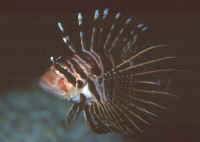
|
|
Taenianotus triacanthus Lacepede
1802, the Leaf Scorpionfish. Indo-pan-Pacific. To four inches
overall length.
Usually found amongst reef rocks on a open setting, rocking
like a falling leaf. Molts twice a month. Feeds on
small fishes, fry and crustaceans. Comes in browns, blacks,
yellows, reds and Below, first row, an assortment
in N. Sulawesi. Second row in Gili Air, Indonesia, light purple!
Second also off Gili Air, the last in Fiji.
|
|
|
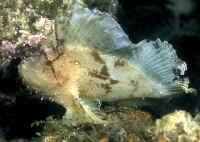
|
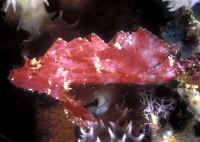
|
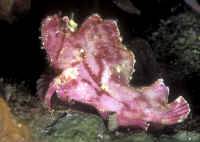
|
|
|
|
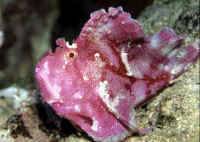
|
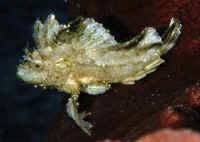
|
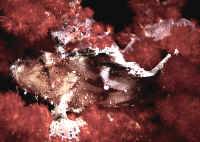
|
|
|
|
|
|
|
|
|
|
|
|
|
Shallow Water Basses, Family
Serranidae:
There is a mix of bass species in Hawaiian waters. Only one large
(imported) species occurs here that is available to aquarists and some
gorgeous smaller species of anthiines and
Liopropoma.
|
Cephalopholis argus Bloch &
Schneider 1801, the Peacock or Argus Hind or Blue-Spotted
Grouper. Indo-Pacific, Red Sea to French Polynesia. Introduced
into Hawai'i and the tropical eastern Pacific coast as a food
and game fish. To a foot and a half in length. Make excellent
aquarium specimens for large fish-only systems.
|
|
Small, medium, and large specimens (6, 12,
16" respectively), in the Red Sea, Hawai'i and French
Polynesia.
|
|
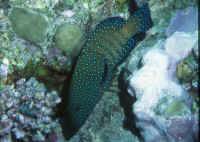
|
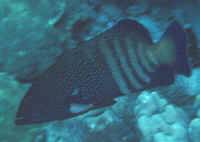
|
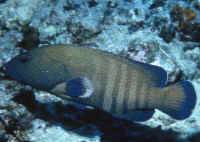
|
Hawkfishes, Family
Cirrhitidae:
Hawkfishes are abundant in the Aloha islands, some hidden between rocks
and amongst coral stands, others boldly perched looking over their
domain.
|
Cirrhitops fasciatus (Bennett 1828),
the Redbarred Hawkfish. Punctuated distribution in the
Indo-Pacific, including Hawai'i (where most often shipped
from), Reunion, Mauritius, Japan, Madagascar. To five inches
overall length. Kailua-Kona, HI image. One of two in the
genus.
|
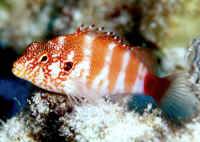
|
|
|
Cirrhitus pinnulatus (Forster 1801),
the Stocky Hawkfish. Indo-Pacific, including the Red Sea. To a
foot in length. This four inch specimen in Hawai'i. An
occasional import that does well in captivity, including reefs
that don't house small motile invertebrates or fishes.
|
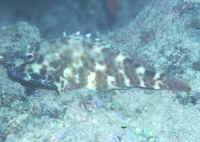
|
|
|
The Arc-Eye hawkfish, Paracirrhites arcatus (Cuvier
1829). With an interesting U-shaped three color patch behind the
eye. They grow to about 5 inches in length and come in two basic
color varieties; one flesh-toned, the other a darker brown based.
Both of these in Hawai'i.
|
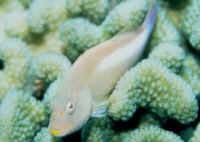
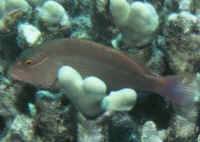
|
|
Forster's or Freckled Hawkfish,
Paracirrhites forsteri (Schneider 1801). With a body
marked by dark spots on the front half and horizontal bands on
the rear. This species can be testy and eat goldfish near their
full length of almost nine inches, so be careful when purchasing
a larger one. Indo-Pacific. Juvenile and adult dark form in
Hawai'i.
|
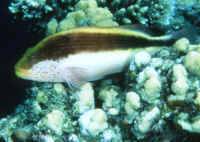
|
|
|
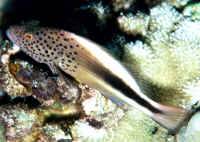
|
Cardinalfishes, Family
Apogonidae:
There are ten species of cardinals that occur in Hawaii. None are
collected for the trade, though one shallow water species that occurs
here does get imported from further into its Indo-Pacific range. Good
for a fill in fish species for a peaceful system.
|
Apogon kallopterus Bleeker 1856, the
Iridescent Cardinalfish. Indo-Pacific, including the Red Sea
(where this one was photographed at night while foraging). To six
inches in length. A larger specimen out during the day in the
Maldives also shown.
|
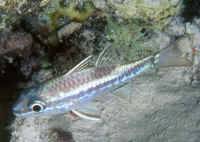
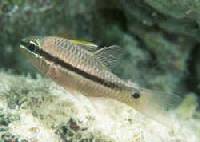
|
Snappers, Family
Lutjanidae:
The only shallow water member of this family in HawaiI used in the
ornamental hobby was actually introduced from the Marquesas in 1958,
and is rarely collected from here for our use.
|
Lutjanus kasmira (Forsskal 1775), the Common Bluestripe
Snapper. Indo-Pacific; Red Sea, eastern Africa to the Marquesas,
south to Australia, over to the Southeast Atlantic; South Africa.
Here in the Maldives and Australia..
|
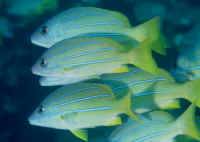
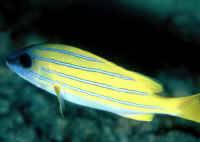
|
Butterflyfishes, Family
Chaetodontidae:
Hawaiian Butterflyfishes span the gamut of the familys aquarium
suitability, with some appropriate generalized zooplanktivore species
to obligate coralivores. About half of the two dozen species that occur
here are occasionally collected for the trade though only the deepwater
Tinkers fetches sufficient divers pay to be attractive to collectors.
From personal experience, I assure you most butterflies are flipped
over fence collection nets and released to the wild.
|
Forcipiger flavissimus Jordan & McGregor
1898, Yellow Longnose Butterflyfish, Forcepsfish. Wide variety of
foods taken, rarely corals. Widest distribution of B/Fs, from
east coast of Africa to west coast of Central America. To eight
inches overall length. Maldives photo.
|
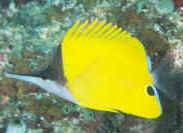
|
|
Forcipiger longirostris (Broussonet 1782), Yellow
Longnose, Long Longnose Butterflyfish. With a longer snout than
its congener and patch of dark spots on the chest to distinguish
the two. Also hardy and about the same size. From east African
coast to mid-Pacific. Dark color forms seasonally seen. Bunaken,
Indonesia and Hawai'i pix.
|
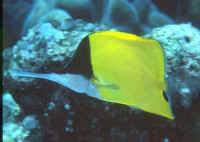
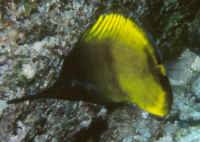
|
|
Hemitaurichthys polylepis (Bleeker
1857), the Pyramid (often sold as H. zoster)
Butterflyfish. Zooplanktivore, living in midwater and feeding in
shoals. Central and western Pacific, including Hawaiian Islands.
To seven inches in length. Aquarium image.
|
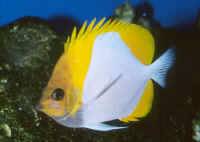
|
|
Heniochus diphreutes Jordan 1903,
Schooling Bannerfish.(1) Similar to the "common heni",
H. acuminatus, but with smaller mouth and more rounded
breast area. Zooplanktivore that excels in a large, un-crowded
system. Cleaners as juveniles. This one in Gili Air, Lombok,
Indonesia.
|
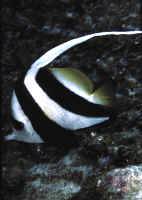
|
|
Chaetodon auriga Forsskal 1775, the
Threadfin Butterflyfish. A great beauty and hardy aquarium
specimen, though it will eat coral polyps and anemones. See other
materials on this species by clicking on name. Widespread
Indo-Pacific. An Auriga B/F in Hawai'i.
|
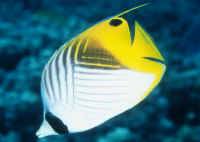
|
|
Chaetodon kleini Bloch 1790, Klein's Butterflyfish.
Widespread from Hawai'i over to Africa's east coast. To
five inches overall. A hardy, but shy species that often perishes
due to too much commotion and competition in captivity. A
juvenile in Hawai'i, an adult one Redang, Malaysia.
|
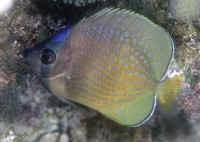
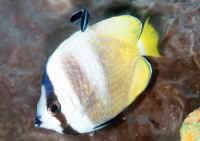
|
|
Chaetodon miliaris Quoy &
Gaimard 1824, the Lemon Butterflyfish. Hardy, abundant and not
hard to catch, this Hawaiian endemic is a real winner that ought
to be used more widely in the trade. Two Hawaiian images to show
degrees of yellow in wild specimens
|

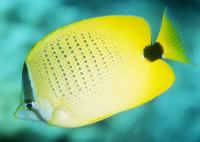
|
|
Chaetodon lunula (Lacepede 1803), the Raccoon Butterflyfish.
Though not as attractive as its namesake in the Red Sea (C.
fasciatus), the Indo-Pacific Raccoon is just as hardy, and a
very good choice for eating pest Aiptasia anemones in reef tanks,
though it will consume coral polyps in some cases. Click on name
for more information, images. This one in the Cook Islands, South
Pacific.
|
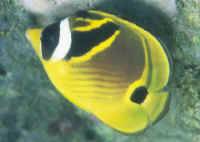
|
|
|
Chaetodon fremblii Bennett
1828, the Blue-Striped Butterflyfish. A relic species confined in
range to the Hawaiian Islands. Opportunistic feeder on algae and
benthic invertebrates including corals. To five inches total
length. Pictured here in captivity.
|
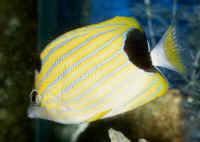
|
|
Chaetodon unimaculatus Bloch 1787,
the Teardrop Butterflyfish. Often, too often imported from
Indonesia, the Philippines and even Hawai'i... like the
similar Indian Ocean species of the same common name this is an
"iffy" fish that mainly perishes due to the rigors of
human (mis)handling. Shown: an adult in Fiji.
|
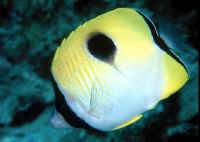
|
|
|
Chaetodon lineolatus Cuvier 1831, the Lined
Butterflyfish. At a foot long, vying for largest of the family.
Widespread from Hawai'i over to the east coast of Africa,
into the Red Sea. A beauty that eats corals, anemones, much of
all else, but doesn't live. One in Hawai'i
|
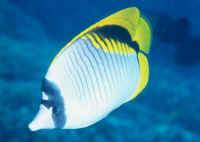
|
|
Chaetodon quadrimaculatus Gray 1831, the
Four-Spot Butterflyfish. Found in the central to western Pacific,
including Hawai'i. To six inches long. A few specimens live
and live, most die "mysteriously" in aquarium
conditions. In the wild, this species feeds principally on
Pocillopora coral polyps. Shown, an adult in the
Cooks.
|
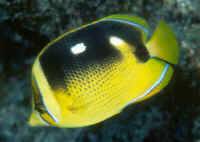
|
|
Chaetodon ornatissimus Cuvier 1831, the Ornate
Butterflyfish. Yet another obligate corallivore. Yes, a beauty,
but does not live in home fish tanks. Indo-west Pacific,
Including Hawaiian Islands. To about seven inches in length.
Commonly offered, doesn't live.
|
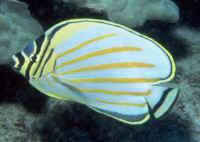
|
|
Chaetodon reticulatus Cuvier 1831, the Reticulated
Butterflyfish. Nice looking, and "friendly" underwater
toward divers, but dismal survival records in captivity for this
coral polyp eater. Found commonly in central and western Pacific.
To six inches total length. One in the Cooks.
|
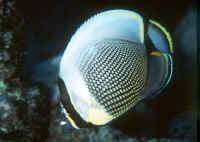
|
|
To: Part 1, Part
2, Part 4, Part 5, Part
6, Part 7,
|
|

